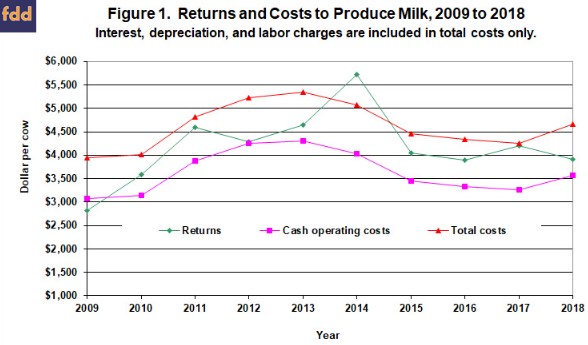By Bradley Zwilling
Lower milk prices still resulted in continued negative economic returns for Illinois dairy producers in 2018, according to figures summarized by the Illinois Farm Business Farm Management Association.
The average net price received per 100 pounds of milk was $16.48, which was less than total economic costs of $19.72. The price received for milk in 2018 was $2.12 lower than 2017. On a per cow basis, total returns from milk were $3,913 compared to the total cost to produce milk of $4,660 per cow. Total returns from milk per cow decreased from 2017. The net returns per cow in 2018 were a negative $747, the lowest since 2012. Total returns have exceeded total economic costs only once out of the last ten years.
Milk production per cow for all herds averaged 23,725 pounds. The average was 1,140 pounds more per cow than in 2017.
Costs and Returns
Trends in total costs and returns per cow for all herds are given from 2009 to 2018 in Figure 1. The profit margin (return above all cost) decreased— from a negative $60 in 2017 to negative $747 per cow in 2018. The last five-year returns above all costs has averaged a negative $198 per cow. During this period, returns above all costs per cow have varied from $662 in 2014 to negative $747 in 2018. In Figure 1, labor and interest charges are included in total costs only. Most dairy producers will incur hired labor and cash interest expense and would include them as cash operating costs.

The 2018 returns were $2.97 per 100 pounds produced less than the 2017 returns. The average net price received for milk was $16.48 per 100 pounds. This is $2.12 per 100 pounds or 11 percent lower than the average price received in 2017. Based on 23,725 pounds of milk produced per cow, this decrease in price decreased total returns per cow by $503. The average net price received for milk for the last five-year period is $18.78 per hundred pounds. Dairy assistance payments from the Farm Service Agency and patronage returns related to the dairy enterprise would add about 51 cents per 100 pounds of milk produced to returns in 2018.
While the price received decreased, feed costs increased while non-feed costs per 100 pounds of milk produced decreased. Feed costs in 2018 averaged $9.95 per 100 pounds of milk produced as compared to $9.08 in 2017. Feed costs were at their highest level ever in 2012. Feed costs have averaged $9.74 the last five years. The 2018 feed costs were 21 cents above the last five-year average. Feed costs were about 50 percent of the total cost to produce milk. Non-feed costs per 100 pounds of milk produced were $9.76 in 2018 compared to $9.79 in 2017. Total non-feed costs were the highest recorded in 2014.
Negative Profit Margins Continue for Dairy Producers in 2019 and 2020
2019 and 2020 milk prices are projected higher than 2018 but will not exceed economic costs resulting in continued negative profit margins for dairy producers. However with higher milk prices, economic returns are projected to be close to breakeven in 2020. The average price received for milk in 2018 was 11.4 percent lower than the average in 2017. The average milk price for 2019 is projected to be about 13 percent more or about $2.20 per hundredweight higher than the average for 2018. Higher domestic demand and lower imports will lead to higher prices. United States milk production is expected to increase about 1.01 percent in 2019. 2020 projections from the United States Department of Agriculture show milk production increasing 1.02 percent from 2019 and milk prices increasing 4 percent from 2019 estimates.
While milk prices increase, feed costs for 2019 are expected to increase. Corn prices will increase in 2019 while soybean prices decrease. Feed costs per 100 pounds of milk produced are projected to average about $10.03 using prices of $3.75 per bushel for corn, 21 cents a pound for protein and $158 a ton for hay. This is based on annual feed consumption per cow, including replacement animals, of 104 bushels of corn, 4,904 pounds of protein, and 8.1 tons of hay or hay equivalents. If non-feed costs per 100 pounds of milk produced averaged $9.60, total costs to produce 100 pounds of milk would be $19.63. A 13 percent increase in milk prices in 2019 for Illinois producers would result in an annual price of about $18.70 per 100 pounds. If total economic costs averaged $19.63 per 100 pounds of milk produced, the average Illinois producer would have returns below total economic costs by $0.93 per 100 pounds of milk produced.
The author would like to acknowledge that data used in this study comes from farms across the State of Illinois enrolled in Illinois Farm Business Farm Management (FBFM) Association. Without their cooperation, information as comprehensive and accurate as this would not be available for educational purposes. FBFM, which consists of 5,500 plus farmers and 60 professional field staff, is a not-for-profit organization available to all farm operators in Illinois. FBFM field staff provide on-farm counsel with computerized recordkeeping, farm financial management, business entity planning and income tax management. For more information, please contact the State Headquarters located at the University of Illinois Department of Agricultural and Consumer Economics at 217-333-8346 or visit the FBFM website at www.fbfm.org.
Source : farmdocdaily